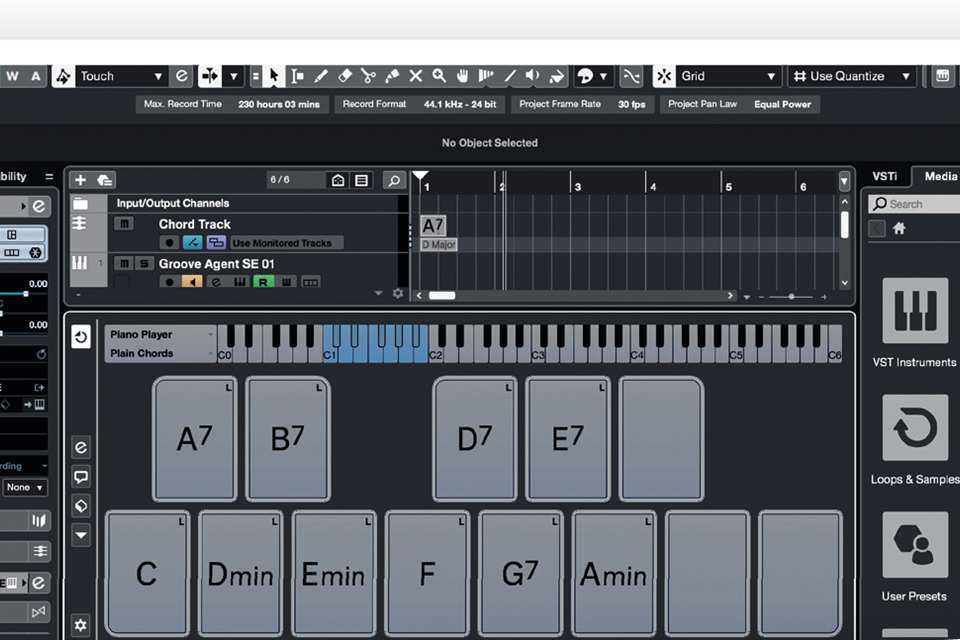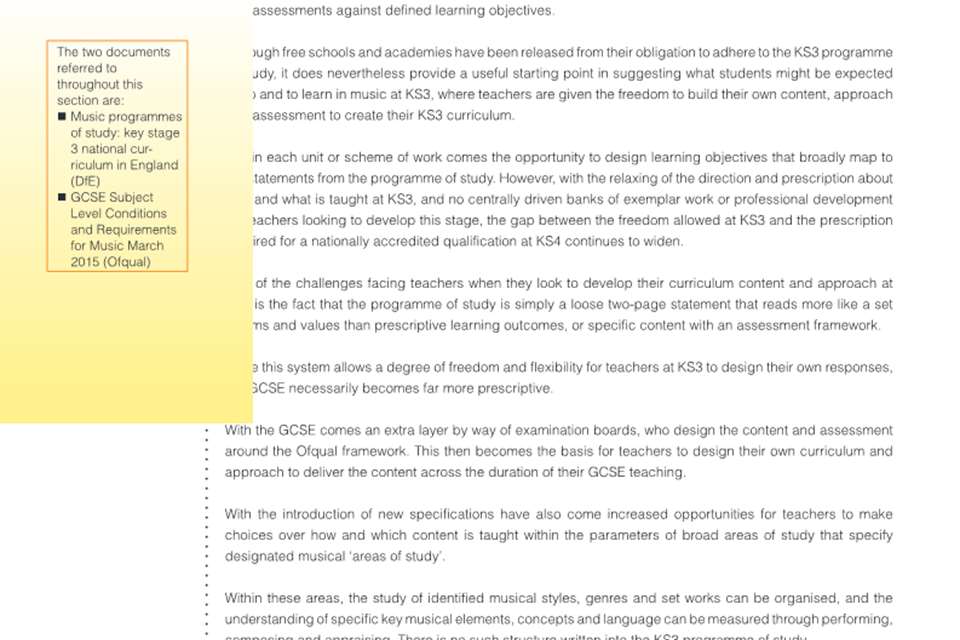Making KS3 Music accessible
Liz Dunbar
Saturday, July 1, 2023
Demystifying musical understanding, the craft of composition and the language can go a long way towards removing barriers in KS3 Music. Here, Liz Dunbar explains how.

Courtesy Liz Dunbar
In my article ‘Sequential learning’ (Music Teacher, April 2022), I wrote about the pathways for GCSE Music performance via music technology. This explained how ‘sequenced realised performance’ (SRP) and ‘production via technology’ routes exist alongside purely live performance at GCSE. For the present article, I want to tackle how we might approach the teaching of listening, analysing, improvising and composing in our everyday KS3 classroom practice, so that studying Music at GCSE is as viable an option as every other subject.
Teaching students to hear and talk like musicians
If you don't start the explicit teaching of musical language until Year 10, there will be a gaping chasm between those who have had specialist tuition and those who have not. Teaching students how to hear and talk like musicians needs to begin in the first week of Year 7. Use specialist language alongside lay language right from the start and at every moment of your hands-on music-making with students in the classroom. Sometimes we, as professional musicians, forget that we're asking students to hear like we do, and to articulate what they hear using specialist vocabulary. We do it without a second thought, but it's a brand new way of listening and thinking to most. As I often say, walk in their shoes.
Structuring how you begin the students' journey of hearing and thinking like a musician takes a lot of intelligent thinking on your part. You need to bring everybody with you, so make what you hear ‘visible’ to students through endless verbal modelling.
Asking ‘elements’-driven questions helps students learn how to pick out specific threads in the music. An instruction like ‘describe what's happening in the music’ early on in the process is really unhelpful. Train students to focus on specifics but do it gradually: in the first instance by simply describing what you hear, then presenting ‘either/or’ choices, and gradually working towards open questions in which students can apply the language they’ve learnt.
Analytical listening: first steps using pre-recorded material
As an example:
- Step 1: The clarinet is playing the melody. Listen to how the line rises higher and higher in pitch.
- Step 2: The clarinet is playing the melody. Is the line rising or falling?
- Step 3: The clarinet is playing the melody. Does the rising line move by step or leap?
- Step 4: The clarinet is playing the melody. Can you describe how it moves?
- Step 5. How can you tell that the clarinet's role is melodic?
Ask questions using specialist language and expect specialist language answers in return. Make it really easy for students to participate by having the walls of your classroom plastered in key terms grouped in elements.
Never miss an opportunity to point out what is going on in a piece of music, or to explain how music works. Listening, explaining and talking about the sound in the room should be a thread that runs through everything you do.
Analytical listening: as part of live music-making
You can apply the same level of analytical listening to the live music-making that's taking place every week:
- How has the group chosen to distribute the parts?
- Is there a steady pulse; has the group managed to stay together?
- There's some nice contrast here in how the chords have been used. Are these block chords or broken to begin with?
- What kind of texture dominates this piece?
- There's a section near the end when the texture thins. What has been taken out?
Make music-chatter part of how students work in pairs and small groups; redirect and refocus these conversations when things slip. Establish this as the norm in the same way that a language teacher does.
And don't just do this in the classroom; do it in rehearsals, in practice rooms, on the corridors. Analyse the intervals of the fire alarm or a ringtone on a freshly confiscated phone. Bring analytical listening into students' everyday lives.
Paving the way to composing independently
Lately, there's a lot of good work going on in terms of demystifying the art of teaching composition in the classroom. It may be that the idea of teaching composition scares the living daylights out of you. Most classroom music teachers identify as performers, not composers, so it's little wonder that teachers tend to avoid composition at KS3. Composing isn't a copying exercise. Students find it difficult to accept that there's no fixed ‘correct’ answer and that they’ve got to dare to fail, and be prepared to go again, time after time. Where else do they find that level of challenge in their average school day?
The trick is to create the right growing conditions and enforce how improvising, composing and arranging are as much part of how students function in your classroom as performing and listening. If you establish this part of musicianship as the norm, then it's more likely that students will accept discovery and experimentation in sound as part of their live music-making. Start small, with tasks that involve students having to make choices as part of their performing and ensemble work.
Here are a few examples to weave into your established KS3 performing tasks to get students away from simply copying you or the dots, and starting to use their ears to make musical decisions:
- Texture: Decide which of the three parts in your group you want to double. Decide if that's going to be at the same pitch, higher or lower. What happens if you loop the first phrase and bring in parts in pairs? Which layers of the texture are you going to present at the start?
- Rhythm: Replace all the semibreves in the accompaniment with repeating quavers. What impact does that have on the music? Try this with crotchets. Which version is most effective? Could you use a combination of all three note-lengths, or alternate them?
- Structure: This piece is made up of two contrasting ideas. Decide how many times you want to use each idea, which idea you want to open and close with, and find out how successful combining the two ideas is. What impact does halving or doubling the length of the opening section have?
- Melody: Instead of simply repeating the given melody in the final section, make a few changes to bar three using the following pitches. Try it with the given rhythm first and then replace both pitch and rhythm.
- Tessitura: What happens if we flip all the parts, so the melody is at the bottom, the bass line on top? Are there any lines that are more effective in their new tessitura? Could a line be used in octaves at different points in the piece? What impact does that have?
- Harmony: Introduce a pedal note at the start. Does the music still work if you sustain or repeat a pedal all the way through? Even if it does work all the way through, does the listener need ‘time off’ from it at some point? Where does the pedal work best in the texture? Try it above, below and in the middle of the texture.
- Compositional device – ostinato: Create a syncopated ostinato using the tonic and dominant, to run throughout the outer sections of the performance.
- Forces: Choose three completely different timbres and see what impact that has on your piece. What impact does their ability to sustain a note have on the overall sound? How might you need to modify the material to accommodate a change in timbre?
- Tonality: What happens to the character of the music if I replace this pitch with this pitch all the way through the piece. What happens if I remove this pitch entirely? Could that work for part of the piece?
And of course…provide realistic models, live in the classroom, in context, along every step of the journey.
There's nothing revolutionary here, but if we consciously and regularly ask students to experiment with existing performance material, their improvising and arranging will naturally lead to the early stages of composing as the confidence and skill in handling musical ideas grow.
We're still a long way off the independent composition work required at GCSE, but we're off the ground. I find that creating ‘holes’ in existing works is a great way to develop students' confidence as improvisers and composers. It works across all genres. At this stage we're still asking students to swim widths not lengths, so provide tightly structured frameworks, modes, scales, a couple of chord choices.
Building on what's gone before
You will have a myriad of composing workshops for Year 10 in your pocket. Modify a couple of them and introduce their central learning points into your Year 8 and 9 schemes. You don't have to start from scratch. The key thing is to weave hands-on musical decision-making into KS3 lessons from the start: low stakes to begin with, then gradually remove the scaffolding.
When students say they're not very musical, remind them that they are. When parents, teachers, cover supervisors, senior leaders say they're not very musical, remind them that they are. We all are. We're just at different points in our understanding and skill in the craft. Instead of those Year 7 starting points remaining fixed, move them forward, so that GCSE Music can be an option for absolutely anyone who has learnt with you at KS3.




